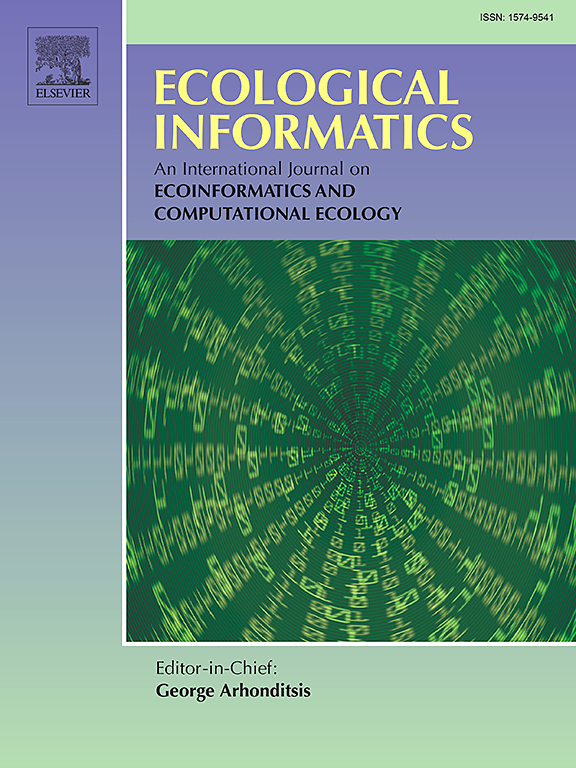珊瑚礁安全人工智能:珊瑚礁图像调查的非分布检测算法基准
IF 7.3
2区 环境科学与生态学
Q1 ECOLOGY
引用次数: 0
摘要
尽管深度学习在定性领域取得了重大进展,但深度学习算法在量化预测的不确定性方面仍然很差。当应用于存在数据移位的领域时,这一点尤其正确,算法已经在这些领域之外进行了训练。这对于使用深度学习来准确估计环境监测应用中的变化具有重要意义。在珊瑚礁栖息地的图像分类中,由于环境条件的变化、不同的传感器和数据捕获的不一致性,时间序列图像很少是一致的,这意味着传统的机器学习指标在应用于新的非分布数据集时根本不起作用。出于这个原因,我们在公开可用的珊瑚礁图像数据集上对最新的最先进的OOD (Out Of Distribution)检测算法进行基准测试,并评估异常值得分的直方图交集作为人类干预的指标。我们通过比较分析表明,OOD检测算法的性能是可变的,并且高度依赖于分布内和分布外的数据组成。我们发现KNN (K-Nearest Neighbour)距离在数据集之间是最一致的,其次是Virtual-logit匹配(ViM)。这项研究展示了一个令人信服的例子,说明了少数公开可用的算法如何轻松地与置信度(Softmax概率)一起用作补充指标,从而为快速报告珊瑚礁栖息地提供更有效和安全的深度学习部署。本文章由计算机程序翻译,如有差异,请以英文原文为准。

Safe AI for coral reefs: Benchmarking out-of-distribution detection algorithms for coral reef image surveys
Although deep learning has demonstrated significant advances in qualitative domains, deep learning algorithms remain poor at quantifying the uncertainty of their predictions. This is especially true when applied in domains where there is data shift outside of which an algorithm has been trained. This has major implications for the use of deep learning in accurately estimating change in environmental monitoring applications. In the case of image classification for coral reef habitats, time series imagery is rarely consistent due to changing environmental conditions, differing sensors and inconsistencies in data capture, which means traditional machine learning metrics simply do not work when applied to new out of distribution datasets.
- 1.For this reason, we benchmark the latest state-of-the-art OOD (Out Of Distribution) detection algorithms on publicly available coral reef image datasets, and evaluate histogram intersection of outlier scores as an indicator for human intervention.
- 2.We show with a comparative analysis that the performance of OOD detection algorithms is variable, and highly dependent on in-distribution and out-of-distribution data composition. We show that KNN (K-Nearest Neighbour) distance was the most consistent across datasets, followed by Virtual-logit matching (ViM).
- 3.This research shows a compelling example of how a handful of openly available algorithms can easily be used as a complimentary indicator alongside confidence (Softmax probability), in turn providing more efficient and safe deployment of deep learning for rapid reporting of coral reef habitats.
求助全文
通过发布文献求助,成功后即可免费获取论文全文。
去求助
来源期刊

Ecological Informatics
环境科学-生态学
CiteScore
8.30
自引率
11.80%
发文量
346
审稿时长
46 days
期刊介绍:
The journal Ecological Informatics is devoted to the publication of high quality, peer-reviewed articles on all aspects of computational ecology, data science and biogeography. The scope of the journal takes into account the data-intensive nature of ecology, the growing capacity of information technology to access, harness and leverage complex data as well as the critical need for informing sustainable management in view of global environmental and climate change.
The nature of the journal is interdisciplinary at the crossover between ecology and informatics. It focuses on novel concepts and techniques for image- and genome-based monitoring and interpretation, sensor- and multimedia-based data acquisition, internet-based data archiving and sharing, data assimilation, modelling and prediction of ecological data.
 求助内容:
求助内容: 应助结果提醒方式:
应助结果提醒方式:


